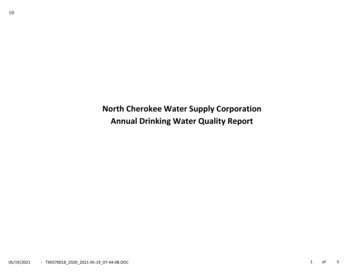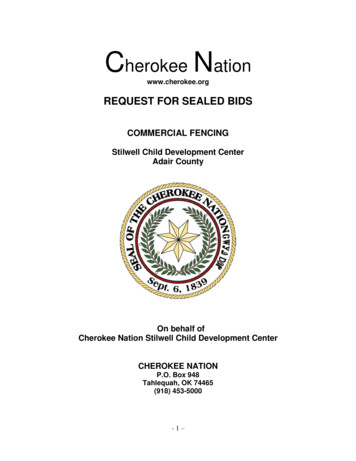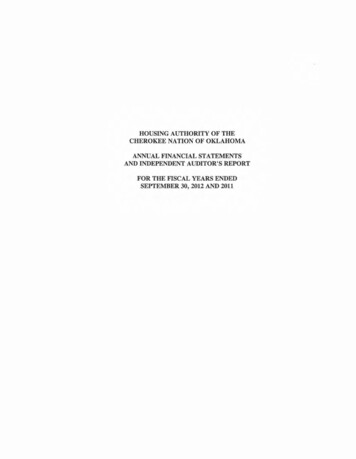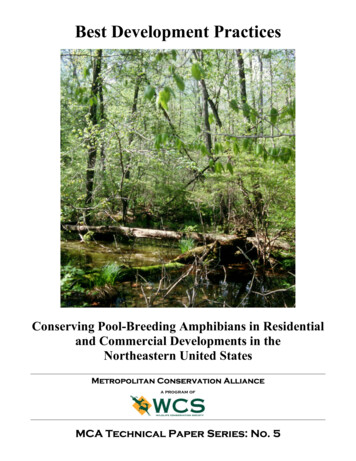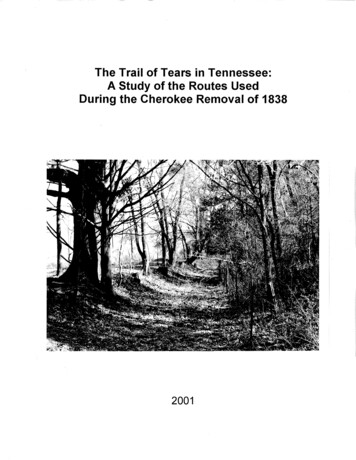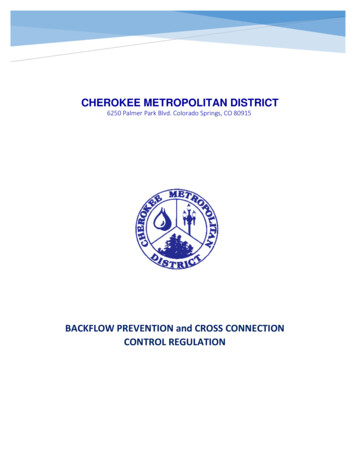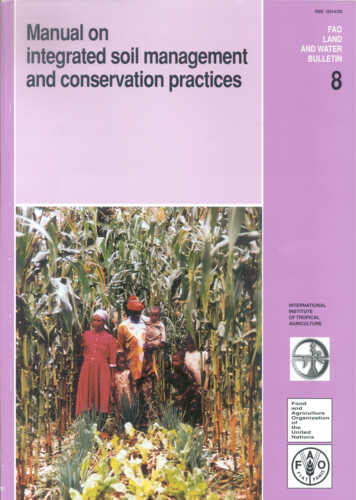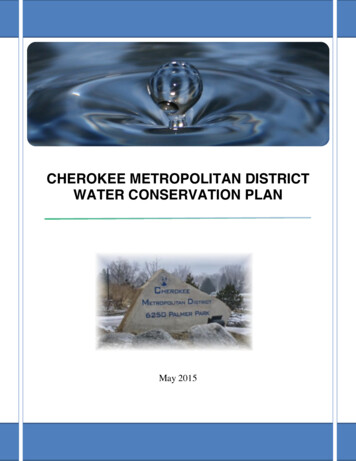
Transcription
CHEROKEE METROPOLITAN DISTRICTWATER CONSERVATION PLANMay 2015
CHEROKEE METROPOLITAN DISTRICT WATER CONSERVATION PLANSubmitted by:56 Inverness Drive East, Suite 112Englewood, CO 80112Project No. 04-14-0063Page 1
CHEROKEE METROPOLITAN DISTRICT WATER CONSERVATION PLANTable of ContentsTable of Contents .iList of Tables .iiList of Figures.ii1.0INTRODUCTION. 11.1.Purpose . 11.2.Background . 12.0PROFILE OF EXISTING WATER SUPPLY SYSTEM. 52.1.Historical Development of CMD . 52.2.Overview of Existing Water Supply System. 52.3.Water Supply Reliability. 82.4.Supply-Side Limitations and Future Needs . 93.0PROFILE OF WATER DEMANDS AND HISTORICAL DEMAND MANAGEMENT. 123.1.Demographics and Key Characteristics of the Service Area . 123.2.Historical Water Demands . 163.3.Historical Demand Management Activities and Impacts to Demands . 183.4.Demand Forecasts . 213.5.Identification and Screening of Potential Conservation Programs . 234.0INTEGRATED PLANNING AND WATER EFFICIENCY BENEFITS AND GOALS. 244.1.Water Efficiency Measures for Consideration . 244.2.Water Efficiency Benefits . 284.3.Water Efficiency Goals . 314.4.Water Conservation Measures Summary. 345.0SELECTION OF WATER EFFICIENCY ACTIVITIES . 395.1.Measure and Program Selection. 395.2.Projected Demand Forecasts with Conservation. 436.0IMPLEMENTATION AND MONITORING PLAN . 446.1.Implementation Plan . 446.2.Monitoring Plan. 467.0ADOPTION OF NEW POLICY, PUBLIC REVIEW, AND FORMAL APPROVAL . 47Page i
CHEROKEE METROPOLITAN DISTRICT WATER CONSERVATION PLANList of TablesTable 1 – Summary of Current CMD Water SuppliesTable 2 – Existing Water Storage TanksTable 3 – Summary of Water SupplyTable 4 – Water Supply Limitations and Future NeedsTable 5 – Water Use by Customer TypeTable 6 – “Water Sales” Water Usage Data by CustomerTable 7 – Per Capita DemandTable 8 – Water Loss and Unit Annual DemandTable 9 – Peak Month and Peak Day Flows and FactorsTable 10 – Cherokee Ridge Golf Course Water UsageTable 11 – SFE Unit Demands Based on Single Family Customer ClassTable 12 – “Water Sales” Water Usage DataTable 13 – Water Loss and Unit Annual DemandTable 14 – Population ProjectionsTable 15 – SFE ProjectionsTable 16 – Projected Water DemandsTable 17 – Water Conservation MeasuresTable 18 – Implementation Schedule SummaryList of FiguresFigure 1 – CMD Service AreaFigure 2 – Existing CMD Water Supply SourcesFigure 3 – CMD Water Usage and ProductionFigure 4 – Monthly Total Well Production 2008-2013Figure 5 – 2015 CMD Water/Sewer RatesAppendix[To be completed following public comment]Page ii
CHEROKEE METROPOLITAN DISTRICT WATER CONSERVATION PLAN1.0 INTRODUCTION1.1. PurposeCherokee Metropolitan District (CMD) is located in an area of anticipated growth on the easternperiphery of Colorado Springs. In order to meet growing demands and reduce reliance onlimited renewable water resources in the region, CMD has been actively engaged inimplementing programs promoting efficient water use. A formal conservation program beganwith the adoption of a conservation plan in 1998. In 2007, the conservation plan was updated tomeet the then current state requirements and implement a more focused management strategythat placed a greater emphasis on responsible and efficient management of CMD’s waterresources.The purpose of the 2015 Water Conservation Plan (WCP) plan is to accomplish two main goals.First and foremost, it evaluates the ongoing conservation efforts implemented following releaseof the 2007 conservation plan, and provides recommendations for other potential measuresmoving forward. Successful programs with potential for additional savings should be consideredto remain in service. For those programs that have run their useful life, or have not yieldedsubstantial water savings, discontinuing them may be in CMD’s best interest. Other measuresnot considered in the 2007 conservation plan should be considered for future implementation.The second objective of the WCP is to remain in compliance with current state requirements forwater conservation planning. This WCP updates the 2007 Plan to meet current requirementsunder Colorado State Statutes, CRS 37-60-126, for “covered entities,” including integration withthe State’s new HB10-1051 Database. This WCP is partially funded under the State’s WaterEfficiency Grant Program.To meet the CMD efficiency goals and comply with State guidelines, the WCP update includesthe following:-Overview of the existing water supply systemExamination of past water conservation program and measured successProposed efficient water use measuresEstimated financial and efficiency impacts of proposed measuresImplementation and monitoring planUpon completion of the WCP, CMD will initiate an outreach program for public and stakeholderinvolvement in implementation of the proposed efficiency measures. A monitoring program willalso be established by CMD to measure the success of each implemented water use program.Through these efforts, CMD plans to improve on its already successful conservation efforts andhas set a goal of three to five percent further reduction in potable water demand over the nextfive years.1.2. BackgroundCMD is a quasi-municipal governmental entity located just outside the city limits of ColoradoSprings, Colorado in El Paso County. CMD was established in 1957. The general boundaries ofPage 1
CHEROKEE METROPOLITAN DISTRICT WATER CONSERVATION PLANCMD are Peterson Air Force Base on the south, Powers Blvd. on the west, a north boundaryapproximately 2 miles north of Constitution Ave. to Barnes Rd., and an eastern boundary thatfollows Highway 24 approximately one mile east of Marksheffel Road to Constitution Avenue.See Figure 1 for a map showing the CMD service area boundaries.Figure 1 – CMD Service AreaCMD relies primarily on alluvial groundwater supplies in the Upper Black Squirrel Basin, asshown in Figure 2. Since 2007, CMD has undertaken efforts to diversify its water supplyportfolio and reduce reliance on delivery of water from Colorado Springs Utilities. This hasincluded the development of a groundwater well field in the Black Forest area to access DenverBasin water owned by CMD, the construction of a new Water Reclamation Facility to treat itswastewater for use in recharge of the Upper Black Squirrel Creek aquifer, and development ofnon-potable wells for irrigation of its golf course.Page 2
CHEROKEE METROPOLITAN DISTRICT WATER CONSERVATION PLANDue to water supply limitations in recent years, CMD has been actively engaged in demandmanagement and conservation efforts, and now has some of the lowest per capita demands inColorado. These low demands were achieved through recommendations for implementation inthe 2007 Conservation Plan. This included various water conservation measures such asimplementation of water reuse, a revised water rate structure, implementation of water-efficientfixtures, and xeric landscaping. The 2015 WCP discusses the outcome of these measures, andrecommends additional alternatives to further enhance CMD’s water-use efficiency.CMD System OverviewCMD currently serves approximately 18,000 customers and its service area encompassesapproximately 6,300 acres. Water use is approximately 65 percent single-family residential, 10percent multi-family residential, and 24 percent commercial, including irrigation. In addition toserving customers within the CMD boundaries, CMD also provides services to several otherareas, including the Schriever Air Force Base and the Woodmen Hills/Meridian RanchDevelopment.A steady population increase is expected to occur at an annual 2 percent rate through the 2040planning period. This results in a 2040 expected population of approximately 28,140. Futuredemands include serving that increasing population, as well the potential addition of new serviceareas.Efficient water use through conservation measures supports CMD’s commitment to a sustainableapproach to water resource management in the region’s semi-arid climate. The WCP identifiesand addresses a variety of water-efficiency measures, including water budgets and tiered rateschedules, new approaches to irrigation scheduling, residential and commercial audits for highusers, rebates for efficient indoor and outdoor uses, and a review of local and state guidelines forefficient water use. Following completion of the WCP, CMD will begin an implementation andmonitoring plan to develop a strategic approach to execute the plan, achieve public andstakeholder support, and develop a system to measure the success of the adopted WCP measures.1.3 WCP OrganizationThe WCP was prepared following the steps in Colorado Water Conservation Board (CWCB)Water Conservation Planning Guidance Document, and is organized accordingly.Page 3
CHEROKEE METROPOLITAN DISTRICT WATER CONSERVATION PLANFigure 2 – Existing CMD Water Supply SourcesPage 4
CHEROKEE METROPOLITAN DISTRICT WATER CONSERVATION PLAN2.0 PROFILE OF EXISTING WATER SUPPLY SYSTEMCMD’s sources of supply are primarily groundwater, and the majority is alluvial groundwater inthe Upper Black Squirrel Creek Designated Groundwater Basin (UBSC). CMD also has accessto additional sources through contractual arrangements with Pueblo Board of Water Works and awater exchange for Guthrie Water, also an alluvial UBSC supply owned by two other districts.CMD is completing construction of the Sundance Ranch water supply system. This is a newDenver Basin groundwater system within Black Forest. It includes facilities to produce, treat,and deliver these supplies.2.1. Historical Development of CMDCMD is a quasi-municipal corporation and a political subdivision of the State of Colorado.CMD was created in 1957 pursuant to Article 1 of Title 32, C.R.S., for the purpose of supplyingwater and sanitary sewer services to its service area. CMD was originally organized as theCherokee Water District on April 19, 1957. In the mid-1960s, Cimarron Sanitation District beganoperations to treat wastewater from Cimarron Hills. A third District, formed in 1978, providedstreet lighting for this unincorporated area of El Paso County.On April 14, 1981, the District‛s Board of Directors adopted a resolution to approve theproposed dissolution of the Cimarron Sanitation District, and to combine the functions ofCimarron into the Cherokee Water District. Cherokee Water and Sanitation District wasestablished on October 23, 1981 following an election within the proposed district.On May 5, 1992 a special election was held to obtain approval of the dissolution of CimarronHills Street Improvement District, the previous provider of certain street services within thedistrict. Also in 1992, the El Paso County Commissioners transferred all of their park lands inthe area to Cherokee. Cherokee Metropolitan District was established on May 11, 1992 toprovide the services previously provided by Cimarron Hills, County Parks, and Cherokee Waterand Sanitation District.2.2. Overview of Existing Water Supply SystemWATER SUPPLY SYSTEMRaw Water SourcesCMD’s water supply is provided through an alluvial well system in the UBSC groundwaterbasin, located approximately 19 miles east of the CMD service area near Ellicott. The UBSCwell field consists of eight wells in the northern part of the Basin (wells 1 through 8) and ninewells in the southern part of the Basin (wells 9 through 17). Figure 2 shows the approximatelocation of the supplies. New Denver Basin wells in Sundance Ranch (Black Forest area east ofMonument) and appurtenant storage, conveyance, and treatment facilities will soon be inoperation.Page 5
CHEROKEE METROPOLITAN DISTRICT WATER CONSERVATION PLANTable 1 presents a summary of CMD’s groundwater wells. The planned production valuesrepresent what the source can actually produce at this time, rather than the decreed amountavailable. No water is shown for the Guthrie wells since this is an exchange of water from thenon-exportable UBSC wells and therefore not an additional source.Table 1 - Summary of Current CMD Water SuppliesWater Supply SourceUBSC Wells In Basin (non-exportable)UBSC Wells ExportableSand Creek Wells (Irrigation)TotalSundance Ranch (Denver Basin)Other SuppliesGuthrie Wells (Exchange)Planned Production (AF)2,8977,05090310,850Up to 2,500 AFY.Operable in early 2015.289 AF exchanged for use out of UBSC basinUBSC WELLS IN-BASIN (NON-EXPORTABLE)The UBSC water comprises the majority of CMD’s existing water supply. This source is dividedbetween two distinctions: exportable and non-exportable. Exportable supplies are permitted tobe used outside of the UBSC while non-exportable cannot. CMD’s service area is not in thedesignated groundwater basin. All of these wells are alluvial.UBSC WELLS EXPORTABLEWater from exportable UBSC wells can be used both in and out of the UBSC.SAND CREEK WELLS (IRRIGATION)CMD owns several shallow wells located in the Cimarron Hill service area, referred tocollectively as the Sand Creek Wells. These wells are shallow alluvial wells, and are usedexclusively for irrigation purposes (primarily the World of Golf and Cherokee Ridge GolfCourses).OTHER SUPPLIESCMD recently ended its Pueblo lease, but has renewed its Guthrie exchange.Guthrie WaterGuthrie Water refers to two alluvial water rights located in UBSC, for a total annual right of 289AF. There are currently two permanent claims under these rights: GTL Development for 200 AF(GTL is the developer of Meridian Ranch), and Woodmen Hills Metropolitan District for 89 AF.Meridian Service Metropolitan District (serving Meridian Ranch) has a water use agreement withGTL for 200 AF. CMD currently has agreements with both GTL and Woodmen Hills MD forexchange of these supplies with in-basin water owned by CMD. Guthrie water is therefore not anadditional source of water but rather an exchange of water that is accounted for in Wells 1-8, sono value is listed in the overall water supply accounting.Page 6
CHEROKEE METROPOLITAN DISTRICT WATER CONSERVATION PLANWATER CONVEYANCE, TREATMENT, AND STORAGE FACILITIESCMD has a collection of wells, pump stations, conveyance pipelines, storage tanks, andtreatment facilities to deliver potable water to its customers. Figure 2 presents majorinfrastructure components within CMD’s system.The general delivery system begins with raw water produced from the north and south well fieldsin the UBSC. Raw water quality from the UBSC is good, and generally only requireschlorination at the wellhead. This water is first delivered to the Ellicott Tank (0.5 MG) locatednear Ellicott. A pump station at the Ellicott Tank conveys water along Highway 94 west to theCMD service are via a 30-inch pipeline. The 30-inch pipeline terminates at Tank 1 (3 MG) atthe south end of Cimarron Hills. Two booster pump stations at Tank 1 can deliver water to Tank2 (3 MG) and Tank 2a (4 MG), located centrally in Cimarron Hills. A booster pump station atthis location delivers raw water to Tank 3 (5 MG), at the northern end of Cimarron Hills.Transmission PipelinesThe transmission system currently includes four distinct segments (italicized facilities representnew facilities under the Sundance Ranch Project) that deliver water into CMD’s main servicearea in Cimarron Hills. Smaller transmission pipelines provide connectivity from CMD’s tanksto its retail customers. The four main delivery segments are:Ellicott Pipeline (30-inch): This is the main pipeline that conveys water from the UBSCwells to the main service area. It is a 30-inch steel pipeline that was constructed in theearly 1960s. The pipeline is approximately 16 miles long and conveys water from theEllicott Booster Station to Tank 1.UBSC North Wellfield Pipeline: The north pipeline consists of two parts, a 24-inch steelpipeline constructed in the early 1980s that goes to Well 1 (about 2.5 miles long), and a20-inch ductile iron pipeline constructed in the 1990s that connects Well 1 to the northernwell (about 6 miles long). Smaller piping spurs connect each well to the pipeline.UBSC South Wellfield Pipeline: The south pipeline consists primarily of 20-inch ductileiron pipe constructed in the early 1990s that conveys water from the southern wells to theHwy 94 pipeline (about 9 miles long). Smaller piping spurs connect each well to thepipeline.Black Forest Pipeline: This 15-mile pipeline consists of 24-inch ductile iron pipe, andconveys water from the Sundance pump station to Tank 3 off Tamlin Road. This systemwill soon be operable.Page 7
CHEROKEE METROPOLITAN DISTRICT WATER CONSERVATION PLANStorage TanksCMD’s storage facilities and associated volumes are shown in Table 2 below.Table 2 - Existing Water Storage TanksTank NameEllicott TankTank 1Tank 2Tank 3 (Tamlin)Tank 4Frank Road TankSundance TankTotalVolume(MGAL)0.53.01.05.03.02.00.515.0Pump StationsThere are currently two primary pump stations that convey water from the source wells to theCimarron Hills service area.Ellicott Booster Station: This pump station currently has four pumps, with space andpiping provisions for three additional pumps. The pump station was constructed in theearly 1990s.Sundance Booster Station: This pump station will have two pumps when complete, withspace for three additional pumps.CMD has additional booster pump stations located within the distribution system to move waterto different pressure zones within its system. These booster pump stations are located adjacent toTanks 1, 2, and 2a.2.3. Water Supply ReliabilityThis section discusses the reliability of CMD’s water supply system in the context of a safetyfactor. This safety factor is presented as a ratio between CMD’s water supply productioncapabilities and CMD’s commitments. Commitments are not actual water sales, rather agreedupon commitments to meet future build-out. Actual consumptive use is less than thecommitments, so a level of conservatism above the safety factor is built into this analysis.As discussed previously, CMD relies almost exclusively on alluvial groundwater in the UBSC toprovide supply to its service area. In early 2015, new Denver Basin supplies acquired throughthe Sundance Ranch Project will be added to CMD’s list of available water supply. The StateEngineer’s Office (SEO) allows Denver Basin groundwater supplies to be pumped at a rate suchthat the source will theoretically provide a water supply for 100 years; i.e., the total volume ofthe aquifer that will be influenced by the well must be divided by 100 years to determine themaximum annual withdrawal rate from the well. El Paso County has a more stringentrequirement that groundwater supplies be planned on the basis of 300 years. This 300-yearallowance is the basis for well yields presented herein.Page 8
CHEROKEE METROPOLITAN DISTRICT WATER CONSERVATION PLANCMD’s alluvial groundwater supplies are separated into exportable and non-exportable supplies.Wells 1 through 8, north of Ellicott, represent the non-exportable supplies. CMD’s in-districtservice area, Cimarron Hills, lies outside of the UBSC designated groundwater basin. Wells 9through 17, south of Ellicott, represent exportable supplies.In order to demonstrate reliability of CMD’s supplies this section will present the commitmentsand supplies for the exportable and non-exportable well system, and the new Sundance Ranchwell field that will be brought online in early 2015. Table 3 shows a summary of the currentwater supplies and commitments. (For more information, see the technical memorandum titled“Cherokee Metropolitan District Update of Commitments and Supplies for State Engineer’sOffice.”)Table 3 - Water Supply SummaryCommitmentsSupplies (Planned Production)UBS Alluvial Non-Export. WellsUBS Alluvial Export. WellsUBS Alluvial Export. Wells (Future)Black Forest Phase 1 WellsBlack Forest Phase 2 WellsDenver Basin Water under CMDTotal SuppliesAFYOut of UBSBasin3,804In ,9922,082SurplusSafety FactorAFY1,1881.317891.612,082Also, CMD operates 5 wells that are collectively known as the Sand Creek wells. These wellshave a planned production of 778 AFY, and are currently used exclusively for golf courseirrigation. Average water use from these wells has been about 150 AFY over the past 5 years.There is a sufficient water supply to meet CMD’s commitments, as shown in Table 3. Somesurplus allows full service in the event certain wells need to be temporarily taken out of servicein the event of an emergency. Within the system, CMD has 12.5 MG of storage (15 MG by theend of the year) that provides sufficient operational storage to meet system demands if anupstream emergency temporarily prevents water deliveries.2.4. Supply-Side Limitations and Future NeedsCMD’s alluvial UBSC groundwater wells are connected to a surface hydraulic system and can beclassified as a renewable resource. Alluvial groundwater rights are considered surface rights,and are therefore regulated by the prior appropriation system like other surface water rights. Themaximum supply side limitations for CMD’s alluvial sources are the decreed amounts. DecreedPage 9
CHEROKEE METROPOLITAN DISTRICT WATER CONSERVATION PLANamounts exceed CMD’s actual demands, so the decrees do not present a supply side limitationfor this supply.Denver Basin wells are a nonrenewable water source. CMD’s supplemental Denver Basinsupplies are not considered a primary sustainable supply beyond the 2050 planning. DenverBasin supplies are an important component in providing an interim supply until other, renewablesupplies are implemented. They also provide functionality in providing an emergency or backup supply in the event of drought or if other systems are interrupted.CMD is taking a multi-faceted approach to meet future water supply needs under the assumptionthat Denver Basin supplies may not be available as a base-loaded supply beyond 2050. Thisincludes increased water efficiency, water reuse, and securing new, renewable water supplies.See Table 4 for an overview of the anticipated future needs and limitations of the CMD watersupply.Water Efficiency - CMD has been successful in implementing water efficient measures in itsservice area, resulting in one of the lowest per capita usages in the state. CMD intends to buildon this success through the implementation of additional measures recommended in this WCP.CMD has set a goal of 3 to 5 percent reduction in per capita use with implementation of therecommended measures.Water Reuse – CMD operates its Water Reclamation Facility (WRF) and Rapid InfiltrationBasins (RIBs), which takes wastewater from CMD’s and Meridian Service MD’s service areas,treats, and discharges to the RIBs. From the RIBs, the water percolates into the ground, blendswith native groundwater, and can be recaptured from CMD’s south USBC well field.New, Renewable Water Supplies – CMD is an active participant in the Pikes Peak RegionalWater Authority (PPRWA), a group of water providers cooperating in the planning of a newregional water supply system.Page 10
CHEROKEE METROPOLITAN DISTRICT WATER CONSERVATION PLANTable 4 – Water Supply Limitations and Future NeedsLimitation and/or Future NeedYesSystem is in a designatedcritical water supply shortageareaSystem experiences frequent watersupply shortages and/oremergenciesNoComments on limitationor future needHow is limitation or futureneed being addressesXXXSystem has substantial non-revenuewaterExperiencing high rates ofpopulation and demand growthPlanning substantialimprovements or additionsIncreases to wastewater systemcapacity anticipatedNeed additional drought reservesXXXXDrinking water quality issuesXElevated TDS in Well13 downstream of theRIBs is minimizing useof this well. Well 13 isdown gradient of theRIBs.Possible modification toWRF to reduce effluent TDSlevels. A facility planningstudy is currently underwayto identify and recommendsolutions to reducegroundwater TDS levels inthe south well field.Aging infrastructure in need of repairXThe EllicottTransmission line wasconstructed in 1964 andis ending its usefulservice life.Condition assessmentunderway to determinerehabilitation optionsCMD’s new DenverBasin groundwatersupplies are a nonrenewable resource.CMD participating in thePPRWA regionalizationstudy exploring alternativesto deliver renewablesupplies, likely from theArkansas River.Issues with water pressure inportions of distribution systemReplacement of nonrenewablesupplies with renewableXXPage 11
CHEROKEE METROPOLITAN DISTRICT WATER CONSERVATION PLAN3.0 PROFILE OF WATER DEMANDS AND HISTORICAL DEMANDMANAGEMENT3.1. Demographics and Key Characteristics of the Service AreaCMD is located in El Paso County, Colorado, on the eastern periphery of Colorado Springs. Inaddition to servicing customers within the CMD boundaries around Cimarron Hills, CMD alsoprovides services to several outside areas. A brief description of CMD’s service customers isdescribed below.Cimarron Hills: This is the main service area of CMD and accounts for about 69 percentof CMD’s total water usage. The majority of the Cimarron Hills service area consists ofresidential customers, with approximately 80 percent single-family housing andapproximately 20 percent commercial customers. There are two golf courses within thisservice area.Schriever Air Force Base: CMD provides water for use at the base and at base housing,which together account for about 12 percent of CMD’s total water usage (10 percent forthe base and 2 percent for base housing).Antelope Acres: This small residential development currently accounts for about 1percent of CMD’s total water usage.Ellicott Springs: This small residential development also currently accounts for about 1percent of CMD’s total water usage.Ellicott School District: CMD provides water for the Ellicott School.Harding Nursery: CMD provides water for the main nursery operation for HardingNursery.Woodmen Hills/Meridian Ranch: CMD currently supplies and exchanges water withthese two districts due to limitations on the usage area of certain water owned by CMD.Water from the Guthrie right (owned by Woodmen Hills/Meridian Ranch) is used inCMD’s system, and water from CMD is provided to Woodmen Hills/Meridian ranch inexchange. This exchange accounts for about 17 percent of the total water usage of CMD.As described above, CMD’s service area consists of single-family and multi-family residentialusers, commercial users, and industrial users. Table 5 provides the breakdown of water usage bycustomer class. Schriever Air Force Base (SAFB) is presented as a separate customer class.SAFB may be considered a general commercial type usage, and SAFB Housing may beconsidered as a multi-family type customer class.Page 12
CHEROKEE METROPOLITAN DISTRICT WATER CONSERVATION PLANTable 5 – Water Use by Customer TypeCustomer ClassAnnual Consumption 401544845111Single FamilyMulti-FamilyCommercial IrrigationCommercialConstruction Meters (In District)Construction Meters (Out of District)SAFBSAFB 131,205213883321143386802,7102421002,234This table does not include water used in exchange with Woodmen Hills or other internal uses.Therefore, the total annual consumption presented in this customer class table is less than totalusage numbers presented elsewhere in this chapter.Total water usage, by customer, is presented in Table 6 below.Table 6 - “Water Sales” Water Usage DataCustomerGeneral CustomersSchriever AFBSAFB HousingEllicott SpringsAntelope AcresWoodman HillsHarding NurseryGolf CourseParks (approx. ater Consumption 3109878801818161621232120305443359588479711
Cherokee Metropolitan District was established on May 11, 1992 to provide the services previously provided by Cimarron Hills, County Parks, and Cherokee Water and Sanitation District. 2.2.Overview of Existing Water Supply System WATER SUPPLY SYSTEM Raw Water Sources CMD's water supply is provided through an alluvial well system in the UBSC .
